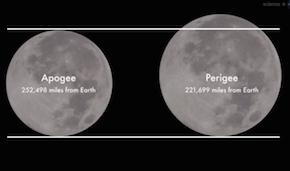The sky’s two brightest planets, Venus and Jupiter, will give us a terrific conjunction of the both of them in mid-August. It is rare for these two consistently bright planets to appear to join in the sky, but before dawn on August 18th (Monday) they will be within 0.2 degrees of each other! Do not wait until the 18th to view these 2 planets however, start about a week before then, looking east-northeast. Venus rises at about 4:30 am, which is some 100 minutes before the Sun, while Jupiter rises at about 5:00 am. On August 12th Jupiter will be seen about 6 degrees to the lower left of Venus. Each morning thereafter the gap will close until on August 18th the separation of the 2 planets will be half of the diameter of the Full Moon. Venus will be the brighter of the two; at magnitude –3.8, while Jupiter will be at –1.8.
Remember that both Venus and Jupiter will be fairly close to the horizon so we will need a clear view to the horizon. Looking across the street into the neighbor’s tree-filled yard will not reveal the horizon very well. After the conjunction the two planets will separate, but the waning crescent Moon will pass close to them on the morning of August 23rd.
Mars and Saturn will form another conjunction this month, but this one will be in the evening sky. On August 10th, Mars will be some 9 degrees west(right) of Saturn in the southwestern sky. By August 20th, the two will be only 4 degrees apart; remaining at about the same distance apart until the 29th or so. Neither are any where nearly as bright as Venus or Jupiter, but are still bright. Both are around +0.6 in magnitude with Mars appearing an orange-red hue and Saturn yellowish-white. The waxing crescent Moon will form a tight triangle with the 2 planets on August 31st, and all three will set around 10:30 pm.
The Full Moon will put a damper on the Perseid Meteor Shower this year; the Perseids being one of the most consistent showers all year. The peak of the shower is August 12/13 which is just two days past Full Moon. So the Moon will brighten the sky enough to cut down on our ability to spot meteors. But the Full Moon in August is the closest Full Moon to Earth for 2014. Recent culture has started to mention “Super Moons’ in recent years. This simply means a Moon that is the closest to the Earth in a calendar year.
The Moon’s orbit around the Earth is elliptical; that is an oval-shape, so each month there is a point where the Moon is at its farthest from Earth (called APOGEE), and a point where is is closest to Earth (called PERIGEE). These points do not always coincide exactly with the Full Moon phase, but when they do, we get the super moon. The August 10th Full Moon will be 221,765 miles from Earth. To give that some meaning, the farthest Full Moon from Earth was on January 15, 2014, at 252,607 miles. This difference of 30,842 miles translates to a 26% brighter Full Moon this August.
The TV, print, and internet media will hype this event; so lets join in and enjoy it too – and hope for clear skies on August 10th!




Write a Letter to the Editor on this Article
We encourage readers to offer their point of view on this article by submitting the following form. Editing is sometimes necessary and is done at the discretion of the editorial staff.